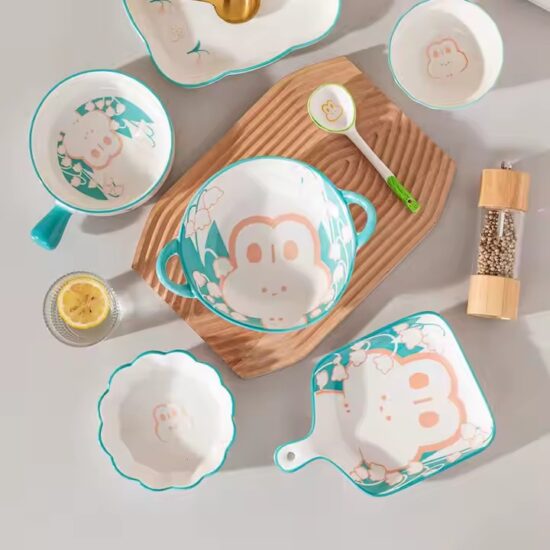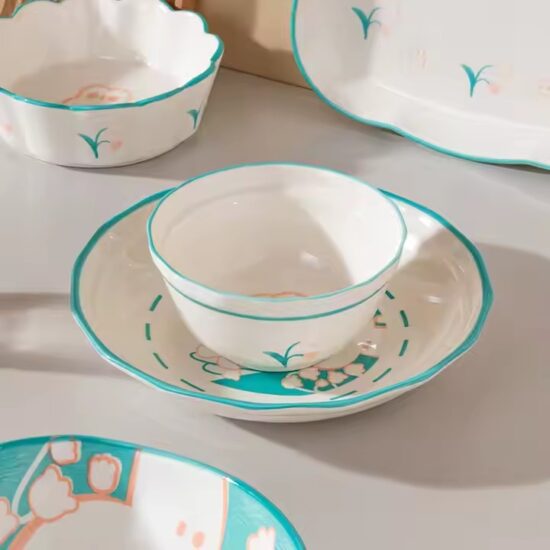bob@nbdho.com
Ceramic Bowls vs Other Tableware Materials: Which is Better for You?
Ceramic Bowls vs Other Tableware Materials: Which is Better for You?
Introduction
Choosing the right tableware can impact not just your dining experience, but also safety, durability, and even your brand image (if you’re a business). Ceramic bowls have been a popular choice for centuries, but how do they compare with other common materials like plastic, glass, stainless steel, and melamine?
Let’s take a deep dive into the advantages and disadvantages of each to help you make the best choice for your home, restaurant, or wholesale business.
1. Ceramic Bowls
✅ Advantages:
-
Elegant and Aesthetic: Offers natural beauty and a wide range of color options.
-
Food-Safe: Lead-free, non-toxic glaze ensures safe food contact.
-
Heat-Resistant: Ideal for microwaves and ovens.
-
Eco-Friendly: Made from natural clay with low environmental impact.
-
Durability: Long-lasting when handled properly.
❌ Disadvantages:
-
Can break or chip if dropped.
-
Heavier than plastic or melamine.
🔄 Best For: Home dining, upscale restaurants, custom branding, eco-conscious customers.
2. Plastic Bowls
✅ Advantages:
-
Lightweight and shatter-resistant.
-
Very affordable and mass-produced.
-
Often available in bright colors and child-friendly designs.
❌ Disadvantages:
-
May release chemicals (like BPA) when exposed to heat.
-
Prone to scratching, staining, and retaining odors.
-
Not microwave-safe in most cases.
🔄 Best For: Casual, short-term use; outdoor activities; children’s products.
3. Glass Bowls
✅ Advantages:
-
Non-reactive and non-porous—great for acidic or hot foods.
-
Transparent design for presentation and food visibility.
-
Safe for microwave and dishwasher (if tempered).
❌ Disadvantages:
-
Fragile; breaks easily.
-
Heavy and less suitable for shipping in bulk.
🔄 Best For: Baking, serving cold dishes, modern minimalist kitchens.
4. Stainless Steel Bowls
✅ Advantages:
-
Extremely durable and resistant to breakage.
-
Lightweight yet strong.
-
Doesn’t absorb odors or flavors.
-
Ideal for commercial kitchens and food prep.
❌ Disadvantages:
-
Not microwave-safe.
-
Limited design or aesthetic appeal.
-
Can dent or scratch over time.
🔄 Best For: Commercial food prep, industrial kitchens, camping gear.
5. Melamine Bowls
✅ Advantages:
-
Shatter-resistant and lightweight.
-
Comes in many patterns that mimic ceramic or porcelain.
-
Often used in food courts and casual restaurants.
❌ Disadvantages:
-
Not microwave-safe.
-
May release harmful chemicals at high temperatures.
-
Lower perceived value than ceramic or glass.
🔄 Best For: Cafeterias, buffets, school dining, informal restaurants.
📊 Comparison Table
| Material | Microwave Safe | Break-Resistant | Food Safe | Aesthetic Appeal | Cost | Durability |
|---|---|---|---|---|---|---|
| Ceramic | ✅ | ❌ | ✅ | ⭐⭐⭐⭐⭐ | Medium | High |
| Plastic | ❌ | ✅ | ❓ | ⭐⭐ | Low | Medium |
| Glass | ✅ | ❌ | ✅ | ⭐⭐⭐⭐ | Medium | Medium |
| Stainless Steel | ❌ | ✅ | ✅ | ⭐⭐ | Medium | Very High |
| Melamine | ❌ | ✅ | ❓ | ⭐⭐⭐ | Low | Medium |
🧠 Conclusion: Which is Better for You?
If you value style, safety, and sustainability, ceramic bowls are a top choice—especially for restaurants, boutique retailers, or high-end branding.
-
For durability and function, stainless steel is unmatched.
-
For budget use, plastic and melamine work—but come with safety and aesthetic trade-offs.
-
Glass strikes a balance but is fragile for shipping and bulk orders.
✅ For wholesalers, restaurants, and brands, ceramic bowls offer the best combination of beauty, safety, and long-term value. And with our custom OEM/ODM ceramic bowl services, you can create unique, high-quality pieces that represent your brand.

